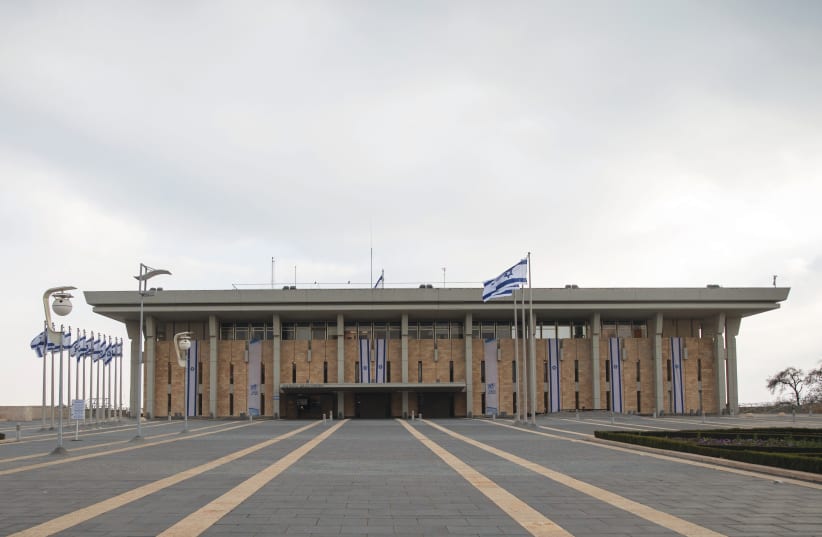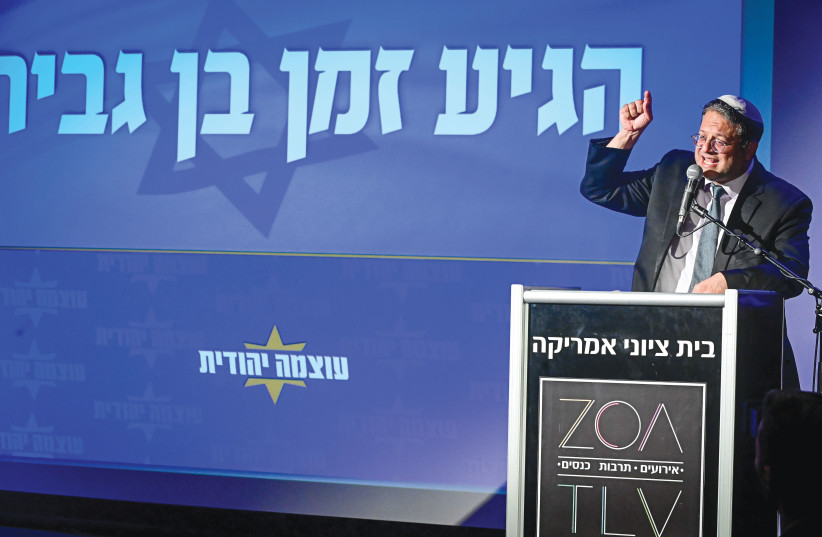How did we get here?
On June 20, then-prime minister Naftali Bennett and current Prime Minister Yair Lapid announced in a dramatic interview that they were ending the “Change Governments” life after one year. Ten days later, the Knesset officially dispersed itself, sending Israel to its fifth election since March 2019 – a span of three and a half years.
By September 15, after two and a half months of campaigning and political wheeling and dealing, 39 parties handed in lists of candidates and became officially eligible to enter the upcoming Knesset, which will be Israel’s 25th.
The 13 parties that were represented in the 24th Knesset have been reconfigured. Defense Minister Benny Gantz’s Blue and White party merged with Justice Minister Gideon Sa’ar’s New Hope party. They then brought on former chief of staff Gadi Eisenkot and former Yamina member and Religious Affairs Minister Matan Kahana, creating the new National Unity Party.
Yamina ceased to exist. Bennett announced that he would not run in the new election, and his longtime ally, Interior Minister Ayelet Shaked, took over and eventually headed Jewish Home (Habayit Hayehudi), the party she and Bennett left in 2018.
The four Israeli-Arab factions that ran together in 2020 and won 15 seats but split into two ahead of the previous election, split yet again. Now there are three Arab parties in the running: Hadash-Ta’al, led by MKs Ayman Odeh and Ahmad Tibi; Ra’am, led by MK Mansour Abbas; and Balad, led by MK Sami Abou Shahadeh.
Meretz, Labor, the Religious Zionist Party and Likud held party primary elections. Meretz chose Zehava Galon, a former party leader, to return and take over, after Health Minister Nitzan Horowitz relinquished the party leadership. Labor chose incumbent Transportation Minister Merav Michaeli to lead it again – and its party members chose younger, newer MKs Na’ama Lazimi and Gilad Kariv to head its list over old-timers, Public Security Minister Omer Bar Lev and Diaspora Affairs Ministers Nachman Shai.
Religious Zionist Party leader MK Bezalel Smotrich was not challenged for the party’s leadership, and neither was Likud leader and former prime minister MK Benjamin Netanyahu. A prolonged negotiation between Smotrich and Otzma Yehudit party head MK Itamar Ben-Gvir ended in the two running together, along with the anti-LGBT party Noam, identical to the previous election. But while Ben-Gvir sufficed with being number two, his party grew stronger and now occupies five out of the top 10 spots.
The Likud primary saw a number of Netanyahu loyalists gaining on Likud old-timers. MKs such as Yariv Levin, Eli Cohen, David Amsalem, Yoav Kisch and Miki Zohar finished in the top 10, while MKs such as Tzachi Hanegbi and Yuli Edelstein lost ground.
Finally, after former MK Yaakov Litzman was forced to resign from the Knesset after agreeing to a plea deal in which he admitted criminally obstructing the extradition of Malka Leifer, an alleged pedophile, newcomer Yizhak Goldknopf took over the hassidic Agudat Yisrael, which, after prolonged negotiations, agreed once again to run with the Lithuanian Degel Hatorah as it has done since 1992, under the banner of United Torah Judaism (UTJ).
What did the campaigns include up until now?
1. High cost of living
The first issue out of the gate was the high cost of living.
The opposition, led by Likud and Shas, argued that the government flopped, as the recent year saw steep price hikes in many sectors, with an overall inflation rate of 5.2%. Although some of the price hikes are due to international events, such as disrupted supply routes caused by the COVID-19 pandemic and the war in Ukraine, the opposition argued that the government did not do nearly enough to combat the rising prices in nearly every sector.
Furthermore, the haredi parties accused the government of slapping specific taxes that hurt the poor, including taxes on plastic-ware and soft drinks. They also attacked an attempt by Finance Minister Avigdor Liberman, leader of Yisrael Beitenu, to change the criteria for government subsidies on daycare centers so that only families with two working parents would be eligible – a change that would mostly harm the haredi sector.
The parties in the current government countered that although prices did indeed rise in the past year, the situation in Israel is among the best in the developed countries. They maintain that Israel’s pre-pandemic high costs of living are rooted in Netanyahu’s policies during the past decade.
They also point out that not only did the government weather the global crisis exceptionally well, but it succeeded in passing measures that were not dealt with in years and are expected to affect the high cost of living. These include reforms on unnecessary standards for imported goods, lowering tariffs on an array of fruits and vegetables, and a reform of the kashrut system – all intended to increase competition and lower prices.
2. Israel’s Jewish character
This issue also took center stage at a certain point in the campaign.
Throughout the past year, the haredi parties expressed their outrage at Kahana’s kashrut reform and Communications Minister Yoaz Hendel’s move to bar the haredi authorities’ control over “kosher” cellular networks. This – coupled with the aforementioned taxes, the threat to haredi family subsidies, and a new salary agreement signed between the finance and education ministries that excluded the independent haredi school system – led to outrage in the haredi community, which claimed that the government was attempting to alter the long-established status quo on matters of religion and state.
The coalition parties, however, argued that they were helping haredi society. The kashrut reform would lower food prices; the kosher cellphone reform would enable haredi citizens to choose what they wanted; the change in government subsidies would encourage them to work; and the demand that the haredi school system teach English and math would help haredim eventually find employment.
The mutual bashing became an all-out war when Michaeli announced during the election season that she planned to introduce public transportation on Saturdays. For the haredi parties, the Religious Zionist Party, and some in Likud, this served as proof that the government would stop at nothing to gain popularity, even if it included what they felt was a significant change to Israel’s character as a Jewish state.
3. Security
The fight over Israel’s Jewish character, however, eventually gave way to a third theme, one that nearly always takes center stage in Israeli elections: security.
Following a wave of terror attacks in March, the security situation again deteriorated in the past couple of months. The northern West Bank has been especially tense, with the Lion’s Den terrorist group carrying out daily attacks on soldiers and civilians. Rioting has also broken out among residents and citizens of Israel in east Jerusalem. Some scenes in recent weeks began to resemble the chaos that ensued in the country’s mixed cities during Operation Guardian of the Walls.
Netanyahu, Smotrich, Ben-Gvir and others on the Right linked the deterioration to the government’s “capitulation” to its new ally, Ra’am. They demanded a harsher response and blamed the government for its weakness and inability to properly deal with the situation.
Lapid, Defense Minister Benny Gantz and the rest of the government countered that Operation Break the Wave, which the IDF launched in response to the terror wave in March, is taking the fight to the terrorists’ home turf in Nablus and Jenin. It also accused Ben-Gvir and his allies of intentionally acting to inflame the situation in order to make the government look bad.
The security discourse heated up over another issue that became central in the past month: Israel’s maritime border deal with Lebanon.
Lapid presented the deal as “historic” and cited the backing of all of Israel’s security agencies as proof that the deal was beneficial for Israel. He accused Netanyahu, who fiercely criticized the deal and called it a “historic surrender,” of spreading lies and acting against Israel’s strategic interest.
Netanyahu and others, however, accused Lapid of capitulating to threats by Hezbollah and harming Israel’s deterrence simply for campaign purposes. He used as proof the fact that Lapid and his cabinet ignored attorney general Gali Baharav-Miara’s preference to bring the vote to the Knesset, which she wrote was the appropriate thing to do, especially during an election campaign.
4. The judicial system
The decision to skip the Knesset vote was ratified by the High Court on Friday, and Lapid is expected to sign the deal with fanfare just days before the election. This led to attacks on the High Court, and thrust a fourth and final issue into the limelight: the judicial system, which, of course, also relates to the endless question of “yes Bibi/no Bibi.”
Smotrich and fellow Religious Zionist Party MK Simcha Rothman presented on October 18 a plan to “restart” the judicial system, called “Law and Justice.” Its many provisions include changing the makeup of the nine-person Judicial Selection Committee in order to give more power to politicians; a bill that the Knesset can re-legislate laws that were overruled by the High Court with a majority of 61; a “French Law” that bars the investigation and indictment of an acting minister, including prime minister, in matters that relate to their role in government; and perhaps most significantly, canceling the fraud and breach of trust offense, which Netanyahu is currently standing trial for.
The Likud did not endorse the plan but said it would “examine” it. For the coalition parties, however, the plan served as proof that the opposition’s central goal was to collapse the judicial system, bar investigations into corruption and, along the way, cancel Netanyahu’s trial.
Bottom line
Perhaps the most apparent and consistent trend of this election is the rise of Ben-Gvir. With his party reaching 14 seats in polls and taking votes from the Likud and the haredi parties, he is emerging as the motor behind his party’s expected third-place finish. Widely viewed as an extremist, Ben-Gvir’s rise is a concern to all of his potential coalition parties. His magnetic ability to attract media and voters has become a concern for his allies as well.
The electoral threshold remains a central question regarding the outcome. Shaked is currently polling well below the 3.25% mark, and if she does not drop out of the race, she may waste tens of thousands of pro-Netanyahu votes.
On the other hand, Balad is expected to waste thousands of anti-Netanyahu votes as well, and Hadash-Ta’al and Ra’am are also not out of the woods. Meretz and Labor are expected to pass, but they too could suffer a setback and perhaps fall under the electoral threshold. The election could very well be decided on whether any of these parties end up falling below the threshold and their votes wasted.
Three main scenarios await voters following November 1.
- The first, and what seems to be the most likely, is that the Netanyahu bloc will receive 61 seats and form a government. In this scenario, Ben-Gvir and Smotrich will become ministers, as will a number of haredi politicians. The Likud will make up the bulk of the government.
- The second is that Lapid or Gantz will form a government. This would either entail support from the haredi parties or mutiny in the Likud – both of which seem highly unlikely. This scenario would involve a wide variety of government ministers and a continuous internal pull and tug, similar to the current one.
- The third scenario, which may very well happen, is that no one forms a government and Israel heads yet again into an election, its sixth in four years. Lapid would remain prime minister, and the current government would continue – without a budget for 2023, and with the country remaining stuck.
The writer is the Knesset correspondent for The Jerusalem Post.

